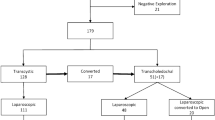Abstract
Background
The role of laparoscopic intraoperative cholangiography (IC) in the diagnosis of asymptomatic choledocholithiasis is still controversial. The aim of this study was to evaluate the diagnostic-therapeutic impact and the educational implications of this method for residents specializing in general surgery.
Methods
We reviewed the records of 835 patients who underwent laparoscopic cholecystectomy for cholecystolithiasis without choledocholithiasis. IC was routinely performed by both expert surgeons and residents in general surgery.
Results
The cholecystectomy was completed laparoscopically in 804 cases, but conversion to open surgery was required in 31 cases. IC was not completed in 140 cases (17.4%), and in 44 cases it revealed a suspected choledocholithiasis. The stones were treated via laparoscopy in 36 cases, laparotomy in six cases, and endoscopic retrograde cholangiopancreatography (ERCP) in two cases. Five patients were not diagnosed with choledocholithiasis. In one case, a lesion of the choledochus was discovered and treated laparoscopically. A total of 610 IC were done by expert surgeons and 225 by residents. The duration of the cholecystectomy with IC was significantly different between the two groups (76.9±12 vs 92.4±11), as was the feasibility index (88.6% vs 80.6%).
Conclusion
Laparoscopic IC is a safe and accurate procedure for the diagnosis of unrecognized choledocholithiasis. Teaching of this procedure as part of the specialization in general surgery would be opportune because it would provide surgical residents with an additional tool for the diagnosis and treatment of this pathology of the common bile duct.
Similar content being viewed by others
References
Caroll BJ, Friedman RL, Liberman MA, Phillips EH (1996) Routine cholangiography reduces sequelae of common bile duct injuries. Surg Endosc 10: 1194–1197
Duensing RA, Williams RA, Collins JC, Wilson SE (2000) Common bile duct stone characteristics: correlation with treatment choice during laparoscopic cholecystectomy. J Gastrointest Surg 4: 6–12
Flowers JL, Zucker KA, Grahm SM, Scovill WA, Imbembo AL, Bailey RW (1992) Laparoscopic cholangiography: results and indications. Ann Surg 215: 209–216
Hunter JG (1992) Laparoscopic transcystic common bile duct exploration. Am J Surg 163: 53–56
Keeling NJ, Menzies D, Motson RW (1999) Laparoscopic exploration of common bile duct: beyond the learning curve. Surg Endosc 13: 109–112
Kondylis PD, Simmons DR, Agarwal SK, Ciardillo KA, Reinhold RB (1997) Abnormal intraoperative cholangiography: treatment options and long-term follow-up. Arch Surg 132: 347–350
Koo KP, Traverso LW (1996) Do preoperative indicators predict the presence of common bile stones during laparoscopic cholecystectomy? Am J Surg 171: 495–499
Kullman E, Borch K, Lindstrom E, Svanvik J, Anderberg B (1996) Value of routine intraoperative cholangiography in detecting aberrant bile ducts and bile duct injuries during laparoscopic cholecystectomy. Br J Surg 83: 171–175
Kullman E, Borch K, Lindstrom E, Svanvik J, Anderberg B (1996) Management of bile duct stones in the era of laparoscopic cholecystectomy: appraisal of routine operative cholangiography and endoscopic treatment. Eur J Surg 162: 873–380
Ladosci LT, Benitez LD, Filippone DR, Nance FC (1997) Intraoperative cholangiography in laparoscopic cholecystectomy: a review of 734 consecutive cases. Am Surg 63: 150–156
Machi J, Tateishi T, Oishi AJ, Furumoto NL, Oishi RH, Uchida S, Sigel B (1999) Laparoscopic ultrasonography versus operative cholangiography during laparoscopic cholecystectomy: review of the literature and a comparison with open intraoperative ultrasonography. J Am Coll Surg 188: 360–367
Olsen D (1997) Bile duct injuries during laparoscopic cholecystectomy. Surg Endosc 11: 133–138
Paul A, Millat B, Holthausen U, Sauerland S, Neugebauer E (1998) Diagnosis and treatment of common bile duct stones (CBDS): results of a consensus development conference. Surg Endosc 12: 856–864
Petelin JB (1993) Laparoscopic approach to common duct pathology. Am J Surg 165: 487–491
Ryberg AA, Fitzgibbons RJ Jr, Tseng A, Maffi TR, Burr LJ, Doris PE (1997) Abnormal cholangiograms during laparoscopic cholecystectomy: is treatment always necessary? Surg Endosc 11: 456–459
Sabharwal AJ, Minford EJ, Marson LP, Muir IM, Hill D, Auld CD (1998) Laparoscopic cholangiography: a prospective study. Br J Surg 85: 624–626
Stuart SA, Simpson GI, Alvord LA, Williams MD (1998) Routine intraoperative laparoscopic cholangiography. Am J Surg 176: 632–637
Author information
Authors and Affiliations
Additional information
Online publication: 11 May 2001
Rights and permissions
About this article
Cite this article
Bresadola, V., Intini, S., Terrosu, G. et al. Intraoperative cholangiography in laparoscopic cholecystectomy during residency in general surgery. Surg Endosc 15, 812–815 (2001). https://doi.org/10.1007/s004640090006
Received:
Accepted:
Issue Date:
DOI: https://doi.org/10.1007/s004640090006




